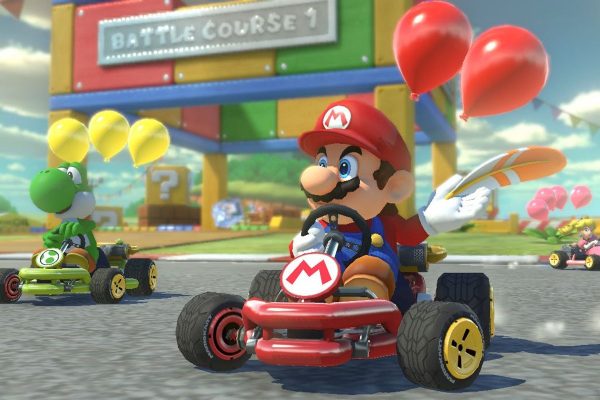We used science to ruin ‘Mario Kart’ and other classic video games

To celebrate the launch of his new book Science-ish: The Peculiar Science Behind the Movies, we asked TV’s Rick Edwards to try and ruin a few of your favourite games for you…
CALL OF DUTY: ADVANCED WARFARE
The makers of Call of Duty: Advanced Warfare claim that “everything in the game is based on current research, or a research paper”. That’s bold, especially when you look at the snazzy combat exo-skeletons the soldiers are bounding around in. These power suits confer super strength and a jumping capacity to make Dalton Grant weak at his unenhanced knees. Back in the real world, there are plenty of exo-suits being developed, including the US military’s TALOS. One problem with body armour is it weighs a ton – almost literally – so the additional strength is mainly useful for heaving the thing about. Jarheads aren’t going to be leaping around in them anytime soon.
The next stumbling block to lurch over in your exo-suit is how to maintain power during combat. Big batteries will add unwelcome weight, but clearly it would be a real shame to find yourself in the middle of a gunfight in hostile territory and run out of juice, stuck in an immovable lump of metal. Yes, battery technology is advancing, but for now it’d probably be worth slapping some solar panels on your back and a mini wind turbine on your helmet. If nothing else it’ll give the enemy something to laugh at.
NO MAN’S SKY
Travelling between (and mining) distant planets is tricky for the simple reason that the distances involved are vast. A so-called generation starship travelling at the speed of Voyager 1 would take 80,000 years to reach our closest star, Proxima Centauri. The crew that reached it would be members of the 2,500th generation – 2,500 generations, in zero gravity, bombarded by radiation. They might not even still be human… or interested in drilling for minerals.
Nevertheless, we are extremely keen on a different kind of extra-terrestrial Gold Rush – sending probes up to have a poke around on nearby (or relatively nearby) asteroids, and then mining the hell out of them. That might all sound a bit Bruce Willis but it’s going to happen imminently. Why? Well, if we do have ambitions to explore the cosmos, we’re going to need to collect simple resources (water and so on) while we’re up there, like stopping at a motorway service station to buy a Ginsters and a Diet Coke. Secondly, we’re running out of stuff on Earth, so it makes sense to look elsewhere for things like precious metals. There’s also an American company who have the first governmental approval to go up to the moon and start digging. Their name? Moon Express. Like Shoe Express, but for moons.
PORTAL
The frontiers of physics tell us that there are 10 dimensions of space, and you can access only one of them. Subatomic particles routinely go forward and backward in time, but you can only go in one direction. What. A. Loser.
In Portal, characters living in just two dimensions use the ‘Aperture Science Handheld Portal Device’ to teleport between different two-dimensional universes. Their guide is a superior AI with a snarky attitude, a bit like that teacher you really hated at school. As for their science, well, it’s not a billion miles off. We are already using our knowledge of quantum physics to teleport atoms (people is going to take a bit longer) and quantum physics experiments have led us to suspect that there really are gazillions of parallel universes just beyond our own. We don’t know how to open a portal, but a black hole looks like it might be an option, as long as you survive the fall to the singularity at the centre (you won’t).
MARIO KART
When dealing with Mario Kart, there is only one go-to research area: pharmacology. As student experiments have proved for decades, smoking banana peel will derail your night – and not in a good way. That’s why the game’s banana peel makes you spin but go nowhere worthwhile.
Mushrooms, however, are a different story. Researchers from Imperial College London have even measured the boost their active ingredient, psilocybin, provides in an fMRI scanner. They found that it enables the left hemisphere of the brain to disconnect from the right, endowing the user with a sense they are disappearing off into the universe, leaving even their own self far behind. It’s the same physiological response that makes Buddhist monks such chill dudes: once you’ve separated your hemispheres, you’re away from the pack.
The turtle shells? They’re ultimate evidence that the creators of Mario Kart really know their shit. Turtle shell might be the street name, but the scientific name is Psilocybe tyrannus: a rare fungus found only on a few tropical islands including Madagascar and the Philippines. The high feels protective, positive and fun, like ecstasy, but its strength means a crash inevitably follows. See what they did there?











